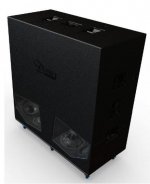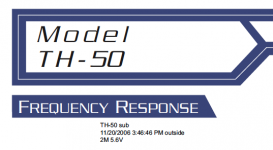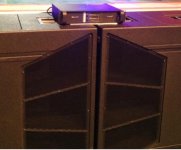Hi Dan,I am aware of ZERO speakers measured at 1w/1m, I've never seen an actual plot. IMO the 1w folks around here seem to be working toward a current drive based measurement and IMO it's of very limited value.
Below are 2 1w plots, please comment on what represents 1w to you...
It is already explained in the single sheet thread. It's not about about a current constant measurement but a current measurement based on Zmin within the passband. Each measurement has its limitation but comparing speakers is usually based on the same amount of power in relation to sensitivity/efficiency.
10-125Hz
6.33 Z min
81.57 Z max
15.394 Z avg
6.33 Z min
81.57 Z max
15.394 Z avg
Code:
10.00 7.34 30.31
10.14 7.38 30.76
10.29 7.42 31.22
10.44 7.47 31.69
10.59 7.51 32.16
10.74 7.56 32.65
10.90 7.61 33.14
11.05 7.66 33.64
11.21 7.72 34.14
11.37 7.78 34.66
11.54 7.84 35.18
11.70 7.90 35.71
11.87 7.97 36.26
12.04 8.04 36.81
12.22 8.11 37.37
12.39 8.19 37.94
12.57 8.27 38.51
12.75 8.35 39.10
12.94 8.45 39.70
13.12 8.54 40.31
13.31 8.64 40.93
13.50 8.75 41.55
13.70 8.86 42.19
13.89 8.98 42.84
14.10 9.11 43.50
14.30 9.25 44.18
14.50 9.39 44.86
14.71 9.55 45.55
14.92 9.72 46.26
15.14 9.90 46.97
15.36 10.09 47.70
15.58 10.30 48.44
15.80 10.53 49.18
16.03 10.77 49.94
16.26 11.04 50.71
16.50 11.33 51.49
16.73 11.65 52.27
16.98 12.00 53.06
17.22 12.39 53.86
17.47 12.82 54.66
17.72 13.30 55.45
17.97 13.85 56.24
18.23 14.46 57.02
18.50 15.17 57.77
18.76 15.98 58.50
19.03 16.93 59.17
19.31 18.04 59.78
19.59 19.38 60.28
19.87 21.00 60.63
20.15 23.02 60.77
20.44 25.59 60.56
20.74 28.94 59.84
21.04 33.49 58.27
21.34 39.92 55.26
21.65 49.34 49.59
21.96 63.16 38.79
22.28 79.25 18.68
22.60 81.57 -10.35
22.92 64.51 -34.61
23.25 47.23 -48.05
23.59 35.44 -54.52
23.93 27.63 -57.24
24.27 22.27 -57.81
24.62 18.43 -56.99
24.98 15.57 -55.18
25.34 13.39 -52.59
25.70 11.69 -49.33
26.07 10.34 -45.49
26.45 9.27 -41.10
26.83 8.41 -36.21
27.21 7.74 -30.88
27.61 7.22 -25.17
28.00 6.83 -19.16
28.41 6.56 -12.96
28.82 6.40 -6.68
29.23 6.33 -0.45
29.65 6.35 5.65
30.08 6.45 11.52
30.51 6.63 17.09
30.95 6.87 22.33
31.40 7.19 27.22
31.85 7.59 31.76
32.31 8.06 35.95
32.77 8.62 39.80
33.25 9.27 43.33
33.72 10.04 46.54
34.21 10.95 49.45
34.70 12.02 52.03
35.20 13.32 54.28
35.71 14.91 56.16
36.22 16.88 57.58
36.75 19.39 58.44
37.28 22.68 58.51
37.81 27.14 57.44
38.36 33.40 54.54
38.91 42.41 48.49
39.47 54.94 36.86
40.04 67.68 16.59
40.62 68.57 -9.45
41.20 56.76 -30.26
41.79 44.39 -42.42
42.40 35.36 -48.88
43.01 29.08 -52.17
43.63 24.60 -53.66
44.26 21.30 -54.06
44.89 18.79 -53.75
45.54 16.82 -52.97
46.20 15.25 -51.86
46.86 13.96 -50.50
47.54 12.90 -48.97
48.22 12.00 -47.29
48.91 11.24 -45.49
49.62 10.59 -43.61
50.33 10.02 -41.65
51.06 9.53 -39.63
51.79 9.10 -37.56
52.54 8.73 -35.44
53.30 8.39 -33.28
54.07 8.10 -31.08
54.84 7.84 -28.85
55.63 7.61 -26.59
56.44 7.41 -24.30
57.25 7.23 -21.99
58.07 7.07 -19.64
58.91 6.93 -17.27
59.76 6.81 -14.87
60.62 6.71 -12.44
61.49 6.63 -9.98
62.38 6.56 -7.49
63.28 6.50 -4.95
64.19 6.47 -2.38
65.11 6.44 0.24
66.05 6.43 2.91
67.00 6.44 5.64
67.97 6.47 8.44
68.95 6.52 11.32
69.94 6.59 14.28
70.95 6.69 17.34
71.97 6.82 20.51
73.01 7.00 23.81
74.06 7.22 27.25
75.12 7.51 30.84
76.21 7.89 34.59
77.30 8.39 38.50
78.42 9.08 42.55
79.55 10.03 46.69
80.69 11.42 50.79
81.85 13.57 54.54
83.03 17.18 57.23
84.23 24.09 56.86
85.44 39.80 46.09
86.67 60.26 0.30
87.92 36.77 -40.80
89.19 22.38 -49.30
90.47 16.00 -48.62
91.78 12.64 -45.11
93.10 10.65 -40.61
94.44 9.38 -35.83
95.80 8.52 -31.09
97.18 7.92 -26.52
98.58 7.49 -22.20
100.00 7.18 -18.14
101.44 7.34 -14.33
102.90 7.38 -10.77
104.38 7.42 -7.41
105.89 7.47 -4.24
107.41 7.51 -1.21
108.96 7.56 1.69
110.53 7.61 4.52
112.12 7.66 7.34
113.74 7.72 10.24
115.38 7.78 13.35
117.04 7.84 16.91
118.72 7.90 20.79
120.43 7.97 16.91
122.17 8.04 5.10
123.93 8.11 8.90
125.71 8.19 12.85Yea I know, I do not subscribe to this theory. Nominal is good enough/ non-confusing/ straight forward enough for comparing things, for me anyway.Hi Dan,
It is already explained in the single sheet thread. It's not about about a current constant measurement but a current measurement based on Zmin within the passband. Each measurement has its limitation but comparing speakers is usually based on the same amount of power in relation to sensitivity/efficiency.
Dag,And while we are at it: its confusing when people show their new Hornresp simulations with 19,2, 27 or 35 volts or whatever.
If we all could keep it at 2,83 volt it will be a lot easier to compare designs.
Preferably in 2pi as most of us cant fly subs!
Dag
Showing a simulation at the highest voltage possible without exceeding Xmax is useful for comparison of maximum SPL potential without excessive distortion. Some designs have high sensitivity, but very low output capability.
A true half space measurement in actuality would require digging a hole in the ground and flush mounting the woofer to equate to a simulation.
Half space measurement is a useful metric for PA use, but many home stereo types put subs in corners counting on 1/4 or 1/8 space in room results.
There is no valid reason to use 2.83 v (one watt with an 8 ohm speaker) when speakers with impedance minimums around 2 ohms are common.
Art
Hi Dag,And while we are at it: its confusing when people show their new Hornresp simulations with 19,2, 27 or 35 volts or whatever.
If we all could keep it at 2,83 volt it will be a lot easier to compare designs.
Preferably in 2pi as most of us cant fly subs!
Dag
I agree with Art and I think you have the wrong idea about the suggestion for HornResp. The 1Watt (or other Watt values) are still based on a voltage constant measurement. The difference with your 2,83V measurement is that the Voltage value is set by the Watt(s) based on the minimum impedance.
When you compare two different designs with the same Voltage you are comparing with different power ratings.
But since this is the thread of Matsj, if you like to reply, in the single sheet you can find the discussion about this tool.
Dag,
Showing a simulation at the highest voltage possible without exceeding Xmax is useful for comparison of maximum SPL potential without excessive distortion. Some designs have high sensitivity, but very low output capability.
A true half space measurement in actuality would require digging a hole in the ground and flush mounting the woofer to equate to a simulation.
Half space measurement is a useful metric for PA use, but many home stereo types put subs in corners counting on 1/4 or 1/8 space in room results.
There is no valid reason to use 2.83 v (one watt with an 8 ohm speaker) when speakers with impedance minimums around 2 ohms are common.
Art
The most valid reason would be that its the most common voltage used in pro audio.
And 1/8 space are more of a wild guess since it requires really really sturdy floor and walls!?
Anyway, i think the discussion about how to meassure secitivity is getting more advanced than it needs to.
Its not that hard to do the math for comparing, Re is close enough!
Dag
I think DSL may use a different throat arrangement than my sketch in post #10, without pulling a speaker it would be impossible to know.Art, this driver is an example of a driver that drops its minimum impedance under high power. Btw most modern 21"or larger do give a different impedance plot between low current measurements and high current measurements. Any idea what throat opening he is using in this cab?
My guess is the throat arrangement on the TH-812 (and DTS-10, IIRC) shows a preference of a “V” shape which may also be incorporated in the TH-221, that shape has some interesting features, it is not used for supposed push pull benefits as is the assumption of some.
The “V” throat shape does not require multiple speakers to be effective.
Then again, my Keystone 18” sub design works well at very high power with a fold pattern similar to my sketch in post #10, though the huge TH-221 allows an additional fold and much longer path length, a requirement for a TH to reach down to the 20 Hz range.
By the way, DSL released a FLH with a keystone shaped exit sometime after my design was posted, for those of you that think obvious visible design features for some reason should not be duplicated.
Regarding the OP, my opinion is the Gjallerhorn would be a better design to pursue for home use, or portable PA use for that matter) unless he has a listening room the size of a 747 airplane hanger.
If one Gjallerhorn was not enough, another could be added and multiple locations could be used, splitting up subs can often provide more even response than a single location.
Art
Attachments
Frequency response appears similar, but output level of the Kraken 2x12 is not even close to the TH-221.Mats, try two of mine Kraken 212 instead. They will suit you perfectly!
The Gjallerhorn is midway in size and output between the Kraken and the DSL TH-221.
Matsj should specify what SPL level, frequency response, size and cost are desired.
Art
Keystoning a FLH mouth has none of the effect that you use it for methinks. I would guess the situation is similar to the TH50 where the internal path borders the mouth and determines the shape. One could say the TH50 was before your TH and therefor you are the one stepping on toes.
Been so long since I looked at the Hornresp horn part descriptions, had to look them upThe V is to get the compression up @ S2.
S1 (or A1) is area at the throat end.
S2 (or A2) is the area at the midpoint of the rear (throat side) of the driver.
The compression ratio at S2 can be the same without using a “V” angle at S2.
The “V” creates a larger volume at S1, that air volume stub may tend to equalize cone pressure as well as smooth upper response peaks.
I don’t know if you will see those effects in Hornresp, you could try making S1 volume double or triple S2 and post results with a design you are familiar with.
Art
The internal path of the DSL DBH-218-LC may border the mouth and determine the shape, hard to tell from the picture.Keystoning a FLH mouth has none of the effect that you use it for methinks. I would guess the situation is similar to the TH50 where the internal path borders the mouth and determines the shape. One could say the TH50 was before your TH and therefor you are the one stepping on toes.
I certainly did not copy the DBH-218-LC (still no specs or pictures on DSL’s website) I saw no pictures until after 6/19/2011 when I saw it here:
New Danley sub
At any rate, Tom Danley and I get along fine, we don’t step on each other’s toes, but it was a surprise to find his new FLH cabinet exit looking so much like my 2x10" Keystone after discussing the Keystone design vs his TH-118 with him previously.
By the way, the TH-50 was tested at 2 meters, the distance I usually test at, some things are just coincidental
Art
Attachments
Found TH-221 drawings on YouTube
There is a YouTube video by "MrFlexy SMPS" that shows TH-221 internals with dimensions. I have screen captured some images and attached to this post. Would be good if someone can take this info and create detailed cut sheet drawings
There is a YouTube video by "MrFlexy SMPS" that shows TH-221 internals with dimensions. I have screen captured some images and attached to this post. Would be good if someone can take this info and create detailed cut sheet drawings
Attachments
-
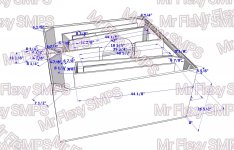 Capture8.JPG240.4 KB · Views: 223
Capture8.JPG240.4 KB · Views: 223 -
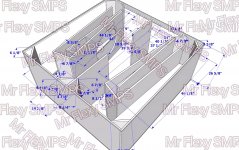 Capture7.JPG321.9 KB · Views: 280
Capture7.JPG321.9 KB · Views: 280 -
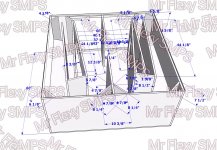 Capture6.JPG266.9 KB · Views: 213
Capture6.JPG266.9 KB · Views: 213 -
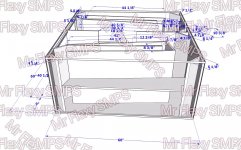 Capture5.JPG280.4 KB · Views: 195
Capture5.JPG280.4 KB · Views: 195 -
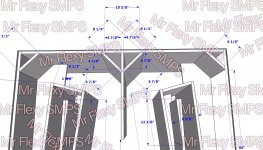 Capture4.JPG294.8 KB · Views: 217
Capture4.JPG294.8 KB · Views: 217 -
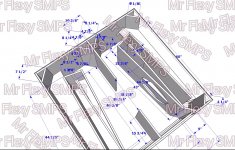 Capture3.JPG322 KB · Views: 250
Capture3.JPG322 KB · Views: 250 -
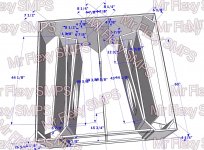 Capture2.JPG285.1 KB · Views: 325
Capture2.JPG285.1 KB · Views: 325 -
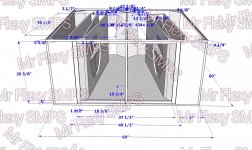 Capture1.JPG264 KB · Views: 487
Capture1.JPG264 KB · Views: 487 -
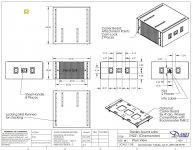 Capture9.JPG228.3 KB · Views: 257
Capture9.JPG228.3 KB · Views: 257
- Status
- This old topic is closed. If you want to reopen this topic, contact a moderator using the "Report Post" button.
- Home
- Loudspeakers
- Subwoofers
- Danley TH-221 drawings ?
